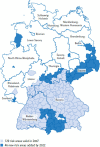Impact of climate change on vector- and rodent-borne infectious diseases
- PMID: 37342429
- PMCID: PMC10278376
- DOI: 10.25646/11401
Impact of climate change on vector- and rodent-borne infectious diseases
Abstract
Background: Endemic and imported vector- and rodent-borne infectious agents can be linked to high morbidity and mortality. Therefore, vector- and rodent-borne human diseases and the effects of climate change are important public health issues.
Methods: For this review, the relevant literature was identified and evaluated according to the thematic aspects and supplemented with an analysis of surveillance data for Germany.
Results: Factors such as increasing temperatures, changing precipitation patterns, and human behaviour may influence the epidemiology of vector- and rodent-borne infectious diseases in Germany.
Conclusions: The effects of climatic changes on the spread of vector- and rodent-borne infectious diseases need to be further studied in detail and considered in the context of climate adaptation measures.
Keywords: ARBOVIRUSES; CLIMATE CHANGE; PUUMALA ORTHOHANTAVIRUS; RESERVOIR HOSTS; VECTORS; ZOONOSES.
© Robert Koch Institute. All rights reserved unless explicitly granted.
Conflict of interest statement
Conflicts of interest Sandra Beermann declares that she has been seconded to the Federal Ministry of Health since June 2022. The other authors declare that there are no conflicts of interest.
Figures






References
-
- Bruce-Chwatt L, de Zulueta J. (1980) The rise and fall of malaria in Europe: A historico-epidemiological study. Oxford University Press, Oxford
-
- Kuhlisch C. (2022) Discovery of Aedes (Ochlerotatus) pionips Dyar, 1919 (Diptera, Culicidae) in Germany. Check List 18:897–906
-
- Pernat N, Kampen H, Jeschke JM, et al. (2021) Citizen science versus professional data collection: Comparison of approaches to mosquito monitoring in Germany. J Appl Ecol 58:214–223
-
- Reisen WK. (1989) Estimation of vectorial capacity: Introduction/relationship to disease transmission by malaria and arbovirus vectors. Bull Soc Vector Ecol 14(2):39–40, 67–70
LinkOut - more resources
Full Text Sources
Other Literature Sources
